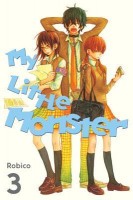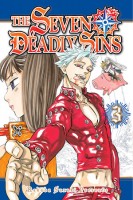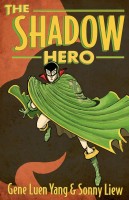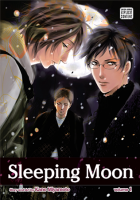My News and Reviews
Last week at Experiments in Manga there were three posts in addition to the usual My Week in Manga feature. To start with, the winner of the Triton of the Sea manga giveaway was announced. The post also includes a list of some of the manga available in English that feature mermaids and/or mermen. Next was my review of Ryo Suzukaze’s novel Attack on Titan: Before the Fall, which is a prequel to Hajime Isayama’s original Attack on Titan manga series. I liked the premise of the novel much more than I did its execution, but it should still be pretty interesting for Attack on Titan fans. And finally, over the weekend, September’s Bookshelf Overload was posted. As for other interesting things online…I’ve been so busy at work lately that I’ve not really been able to keep up with all that’s going on. However, I do know that Seven Seas is currently in the process of revealing seven new licenses via Twitter. I’m pretty sure that Sean will be doing a wrap-up at A Case Suitable for Treatment soon which I’ll link to, but in the meantime you can always check out Seven Seas’ Twitter timeline. (There have been some really interesting choices so far!)
Quick Takes
 My Little Monster, Volume 3 by Robico. I have been thoroughly enjoying My Little Monster and its cast of rather quirky characters. However, the third volume doesn’t seem to really move the plot along much, nor does it really develop the characters further. If anything, the series has lost its forward momentum and undoes some of the progress that has been made. After the various confessions of love from the previous volumes, Haru and Shizuku spend most of the third going through it all again. Shizuku has once more decided that she doesn’t have time for friendships or romantic relationships and wants to focus on her studies. Haru is fitting in a little better at school and is actually able to put the fact that everyone except Shizuku is terrified of him to good use, although he’s still fairly volatile and his behavior and obliviousness of others occasionally causes some real problems. So overall, not much has really changed in My Little Monster except that a few more hints have been dropped about Haru’s brother, whom I’m very curious about. I’m still enjoying the series and find its deadpan humor amusing, but I do hope to see more plot and character development in future volumes.
My Little Monster, Volume 3 by Robico. I have been thoroughly enjoying My Little Monster and its cast of rather quirky characters. However, the third volume doesn’t seem to really move the plot along much, nor does it really develop the characters further. If anything, the series has lost its forward momentum and undoes some of the progress that has been made. After the various confessions of love from the previous volumes, Haru and Shizuku spend most of the third going through it all again. Shizuku has once more decided that she doesn’t have time for friendships or romantic relationships and wants to focus on her studies. Haru is fitting in a little better at school and is actually able to put the fact that everyone except Shizuku is terrified of him to good use, although he’s still fairly volatile and his behavior and obliviousness of others occasionally causes some real problems. So overall, not much has really changed in My Little Monster except that a few more hints have been dropped about Haru’s brother, whom I’m very curious about. I’m still enjoying the series and find its deadpan humor amusing, but I do hope to see more plot and character development in future volumes.
 The Seven Deadly Sins, Volume 3 by Nakaba Suzuki. As can be safely assumed from the cover, the third volume of The Seven Deadly Sins heavily features the newly introduced Ban, the Fox Sin of Greed. I’m okay with this because, well, I actually like Ban as a character. Despite being one of the Seven Deadly Sins and therefore being one of the series’ heroes (or at least one of its protagonists), Ban’s really not that nice of a guy. Frankly, he’s an unapologetic jerk (with a very nice set of abs and a fondness for alcohol, though he really can’t hold his drink). But, like the other Sins, Ban has a tragic past to go along with his arrogant personality. He’s also kind of a goofball. One of the things that I particularly enjoy about The Seven Deadly Sins is the ridiculously overpowered battles between the ridiculously overpowered characters. The action can sometimes be a little difficult to follow, but the resulting destruction is quite obvious. I’m also rather impressed by how well Suzuki visually handles Diane, the giantess of the Seven Deadly Sins. She’s huge, but her presence always seems very natural on the page and Suzuki does a nice job of incorporating her into the artwork.
The Seven Deadly Sins, Volume 3 by Nakaba Suzuki. As can be safely assumed from the cover, the third volume of The Seven Deadly Sins heavily features the newly introduced Ban, the Fox Sin of Greed. I’m okay with this because, well, I actually like Ban as a character. Despite being one of the Seven Deadly Sins and therefore being one of the series’ heroes (or at least one of its protagonists), Ban’s really not that nice of a guy. Frankly, he’s an unapologetic jerk (with a very nice set of abs and a fondness for alcohol, though he really can’t hold his drink). But, like the other Sins, Ban has a tragic past to go along with his arrogant personality. He’s also kind of a goofball. One of the things that I particularly enjoy about The Seven Deadly Sins is the ridiculously overpowered battles between the ridiculously overpowered characters. The action can sometimes be a little difficult to follow, but the resulting destruction is quite obvious. I’m also rather impressed by how well Suzuki visually handles Diane, the giantess of the Seven Deadly Sins. She’s huge, but her presence always seems very natural on the page and Suzuki does a nice job of incorporating her into the artwork.
 The Shadow Hero written by Gene Luen Yang and illustrated by Sonny Liew. Initially I wasn’t planning on picking up The Shadow Hero, most likely because I’m generally not that interested in superheroes. Fortunately I realized that was a very silly reason not to read the comic, especially considering that Yang is a fantastic writer and I really like Liew’s artwork and use of color. Long story short, I absolutely loved The Shadow Hero. The story of The Shadow Hero was inspired by an obscure superhero from the 1940s called the Green Turtle which was created by Chu Hing, one of the first Asian Americans to work in American comics. (The volume also contains a reproduction of the first Green Turtle comic, which was a nice addition.) The Shadow Hero serves as the Green Turtle’s origin story. Hank Chu is the son of a Chinatown grocer who looks forward to taking over his father’s store. His mother, however, has much bigger plans for her son and has decided that he will become a superhero, despite the complete lack of any superpowers. With a great story and great art, and plenty of humor to balance the more serious aspects of the comic, The Shadow Hero is definitely recommended.
The Shadow Hero written by Gene Luen Yang and illustrated by Sonny Liew. Initially I wasn’t planning on picking up The Shadow Hero, most likely because I’m generally not that interested in superheroes. Fortunately I realized that was a very silly reason not to read the comic, especially considering that Yang is a fantastic writer and I really like Liew’s artwork and use of color. Long story short, I absolutely loved The Shadow Hero. The story of The Shadow Hero was inspired by an obscure superhero from the 1940s called the Green Turtle which was created by Chu Hing, one of the first Asian Americans to work in American comics. (The volume also contains a reproduction of the first Green Turtle comic, which was a nice addition.) The Shadow Hero serves as the Green Turtle’s origin story. Hank Chu is the son of a Chinatown grocer who looks forward to taking over his father’s store. His mother, however, has much bigger plans for her son and has decided that he will become a superhero, despite the complete lack of any superpowers. With a great story and great art, and plenty of humor to balance the more serious aspects of the comic, The Shadow Hero is definitely recommended.
 Sleeping Moon, Volumes 1-2 by Kano Miyamoto. I tend to really enjoy Miyamoto’s work, so I was pretty excited when SuBLime licensed her short boys’ love series Sleeping Moon. I was particularly looking forward to it due to its supernatural elements, but in the end I didn’t find it as compelling as some of her other manga which are more firmly based in reality. Part of that is probably because much of the romantic relationship between two of the leads felt as though it was tacked on simply because the series was supposed to be boys’ love. Still, there were parts of Sleeping Moon that I enjoyed, and Miyamoto’s artwork is as lovely as ever. Akihiko’s family is cursed—the male heirs all die young, never making it past their thirties. And since his thirtieth birthday is fast approaching, Akihiko has a vested interest in discovering the truth behind the curse in order to prevent his own death and the death of his cousin. And that’s when the time slips begin—Akihiko finds himself spontaneously traveling to the Meiji era where one of his distant relatives is trying to unravel the same mystery. The moody supernatural and horror elements work better than the manga’s romance and the time traveling is handled quite well, too.
Sleeping Moon, Volumes 1-2 by Kano Miyamoto. I tend to really enjoy Miyamoto’s work, so I was pretty excited when SuBLime licensed her short boys’ love series Sleeping Moon. I was particularly looking forward to it due to its supernatural elements, but in the end I didn’t find it as compelling as some of her other manga which are more firmly based in reality. Part of that is probably because much of the romantic relationship between two of the leads felt as though it was tacked on simply because the series was supposed to be boys’ love. Still, there were parts of Sleeping Moon that I enjoyed, and Miyamoto’s artwork is as lovely as ever. Akihiko’s family is cursed—the male heirs all die young, never making it past their thirties. And since his thirtieth birthday is fast approaching, Akihiko has a vested interest in discovering the truth behind the curse in order to prevent his own death and the death of his cousin. And that’s when the time slips begin—Akihiko finds himself spontaneously traveling to the Meiji era where one of his distant relatives is trying to unravel the same mystery. The moody supernatural and horror elements work better than the manga’s romance and the time traveling is handled quite well, too.













